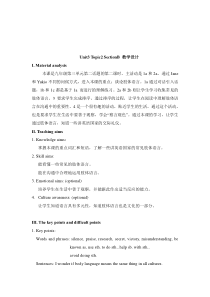 DOC
DOC
【文档说明】Unit 3 Topic 2《Some things usually have different meanings in》(SectionB)教学设计-九年级上册英语【仁爱版】.doc,共(10)页,51.000 KB,由小喜鸽上传
转载请保留链接:https://www.ichengzhen.cn/view-104586.html
以下为本文档部分文字说明:
Unit3Topic2SectionB教学设计Ⅰ.Materialanalysis本课是九年级第三单元第二话题的第二课时。主活动是1a和2a。通过Jane和Yukio不同的问候方式,进入本课的重点:谈论肢体语言。1a
通过对话引入话题,1b和1c都是基于1a而进行的理解练习。2a和2b则让学生学习收集常见的肢体语言。3要求学生完成排序,通过排序的过程,让学生在阅读中理解肢体语言在沟通中的重要性。4是一个很有趣的活动,贴近学生的生活。
通过这个活动,也是要求学生在生活中要善于观察,学会“察言观色”。通过本课的学习,让学生通过肢体语言,知道一些讲英语国家的交际礼仪。Ⅱ.Teachingaims1.Knowledgeaims:掌握本课的重点词
汇和短语,了解一些讲英语国家的常见肢体语言。2.Skillaims:能看懂一些常见的肢体语言。能在沟通中合理地运用肢体语言。3.Emotionalaims:(optional)培养学生在生活中善于观察,并能据此作出适当反应的能力。4.Cult
ureawareness:(optional)让学生知道语言具有多元性,知道肢体语言也是文化的一部分。Ⅲ.Thekeypointsanddifficultpoints1.Keypoints:Wordsandphrases:silence,praise,research,secret,vi
ctory,misunderstanding,beknownas,usesth.todosth.,helpsb.withsth.,avoiddoingsth.Sentences:Iwonderifbodylanguagemeansthesamethinginallcul
tures.Ithinkthatisknownasbodylanguage.Grammar:Expressingthefuturebypresentcontinuous.2.Difficultpoints:能理解在不
同的国家,同一个肢体语言的含义是有差异的。Ⅳ.Learningstrategies在交际的过程中,遇到语言障碍,能运用肢体语言来辅助交际。在学习的过程中,要有意识地收集一些讲英语国家的常见肢体语言。在做1c时,要学会使用速记的方法。Ⅴ.Teachingaids图片/录音机/幻灯片/准备好材料的
小黑板/卓别林的幽默剧片段等。Ⅵ.TeachingproceduresStage(timeperiod)InteractionpatternsTeacheractivityStudentactivityRemarks1Gettingstudentsrea
dyforlearning(2mins)ClassactivityChoosesomeSstoplaythegame“Isay,youdo”.T:Hi,everyone!Funtimenow!Wouldyouliketoplayagamewithme?Whowa
ntstotry?Don’tworry.It’sveryeasy.JustactoutwhatIsay.T:Goodluck.T:Showrespect.T:Expressanger.T:Showagr
eement.T:Showfriendship....Listentotheteacher’sinstructionsandactaccordingly.老师可以把1a和3里面的肢体语言编进来。能够播放一小段卓别林
的幽默剧更好,无声电影都是通过肢体语言来表达的。2RevisionIndividualPreparesomeChineseTranslatethesentences用现在进行时(3mins)worksentencesandasktheSstotranslatethemintoEng
lishandthenreadthemout.T:Lookatthesesentences,youhavetoputthemintoEnglishonapieceofpaper,thenIwillchoosesomeSstoreadyoursentences.intoEnglisha
ndreadthemout.S1:TheyareleavingforBeijingtomorrow.S2:Mr.Whiteisstayinghereforonlythreedays.S3:Mymomiscookinginthekitchennow.S4:MissLeeiscomingbac
kinthreedays.态表示正在进行的动作和表示将要进行的动作都要有所体现。3Pre-listening(3mins)IndividualworkLettheSsreadthestatementsin1band1candlearn“bow,hip”bythem
selves.T:Readthestatementsin1b,1c.Trytolearnthetwonewwordsbyyourselves.Ifyouhaveanydifficulty,youcanaskyo
urpartnerormeforhelp.Readthestatementsin1band1c.Learn“bow,hips”.Guesssomeoftheblanksin1c.让学生学会在听前进行猜测
。4While-listening(6mins)IndividualworkIndividualworkStep1:Playthetaperecorder.LettheSsdo1b.T:Listentoth
etape,do1b.Step2:Playthetaperecorderagain.LettheListento1aanddo1b.Listento1aagainanddo1c.在学生做1c时,老师要告诉学生:不要试图一次性写完单词,Ssdo1c.Tell
theSstowritetheshortformsatfirstandthenwritedownthefullwords.T:Listentothetapeagain.Thistime,youfillintheblanks,butdo
n’ttrytocompletethewordsatonetime;youcanjustwritetheshortformsatfirst.Youcanfinishthemafterlistening.只需要要写一个自己明
白的简体,听完以后再补充完整。5Post-listening(23mins)IndividualworkGroupworkGroupworkStep1:LettheSsread1a,findthenewwords“silence,praise,r
esearch”,checktheanswersto1band1cbythemselves,thenchecktogether.Finish1band1c.T:Now,let’schecktheanswers
.Step2:LettheSsread1aagain,discussingroupsandlistthekeyRead1a,findthegivenwords,learnthewordsandchecktheanswer
s.S1:T,T,F,F,F.S2:body,respect.S3:peace,friendship.S4:happy,cultures,communicate.Read1aagain,discussingroupsandlistthekey
points.S1:beknownas,usesth.todosth.S2:helpsb.withsth.S3:dosomeresearch,让学生通过构词法、反义词来学习新词的读音或含义。Silent-silencere+sea
rch=researchPunish-praise通过图片直接IndividualworkGroupworkGroupworkpoints.Finish1a.T:Read1aagain,discussingr
oups,andlistthekeypoints.Step3:LettheSsstudyanddiscussthegesturesin2aandtrytomatchthemeaningwiththegesture.T:Wehav
elearnedsomegestures,nowwewilllearnmore.Studyanddiscussthegesturesin2a.Trytomatchthemcorrectly.Step4:Checktheanswersandteachthenewwords“secret,p
uzzled,victory”.Finish2a.Step5:LettheSsdiscussingroups.Collectmoregestures.Encouragesomegroupstoactout,andlettheotherSsguessas
asignof,...Study2aanddiscussingroups.Matchthemeaningwiththegesture.Checktheanswersandlearnthenewwords.S1:f,d,e,b,c,a.Discussingroups,ac
toutandguess.Finish2b.S2:Tiredandsleepy!S4:Haveatoothache!Discussoneoftheteachers’typicalbodylanguageandrep
orttotheclass.Finish4.S1:MissZhang’stypicalbodylanguageistouchingherhair.S2:Mr.Wang’stypicalbodylangu
ageis展示2a,让学生说出含义更好,老师可以在解释的过程中顺便教授新词汇。在学生讨论时,老师要适当提供帮助,有些动词或名词学生可能不会表达。汇报完以后,选出描述得最惟妙惟肖的组别。whattheymean.Finish2b.T:Besidesthesege
stures,doyouknowanyothergestures?Pleasediscussingroups,thenactthemoutinthefront,theotherSswillguess.Goahead!S1:(acttobetiredand
sleepy)S3:(acttohaveatoothache.)Step6:LettheSsreadtheinstructionsin4anddiscussoneoftheirteachers’typicalbodylanguage.
Encouragethemtoreporttothewholeclass.Finish4.T:Haveyouevernoticedmybodylanguage?Ofallyourteachers,whohasthemosttypicalb
odylanguage?Now,discussingroups,andrubbinghisnose.S3:..thenreporttotheclass.Theexamplemayhelpyoualot.Payattentiontothe
liaisonandintonation.6FinishingTask3(4mins)IndividualworkandGroupworkLettheSsread3carefullyandputitinthecorrectorder.FirstlettheSsdoitalone,and
thencheckingroups.RemindtheSstopayattentiontothetopicsentence,thesupportingsentenceandtheconjunctionwords:but,so,however
.T:Now,let’smoveto3.Readthesentencesfirst,andthenputthemintherightorder.Beforeyoubegintoorder,youhadbetterfindthetopicsente
nceandthesupportingsentences.Payattentiontotheconjunctionslike“but,so,however,forRead3andputthesentencesinthecorrectorder.Checktheanswers
.S1:1-4-3-7-6-2-5.S2:1-3-4-7-6-5-2.S3:...Ss:1-3-4-7-6-5-2.老师一定要告诉学生做这种排序题的技巧。通过中心句和关联词等来排序。强调词组:avoiddoingsth.。example”.Ifyoufinish,checkit
inyourgroup.Wewillcheckittogetherlater.T:Canyoutellmeyourordernow?T:Ok,youhavedifferentanswers.Whatistherightorder
?7Summarizingandassigninghomework(4mins)GroupworkStep1:LettheSssumupwhattheyhavelearnedinSectionB.T:Howtimeflies!Thereisnotmuchtimel
eft.Weoughttosumupthekeypoints.Let’sbeginwiththenewwords.T:Andphrases?T:..Step2:HMK:LettheSssearchsomeChinese
idiomsaboutdogs,dragonsandmice.Findoutthespecialmeaningsofpeacock,bat,andSumupandspeakthemout.S1:bow,hip,..S2:silence,praise,research,..S3:
beknownas,usesth.todosth.,S4:dosomeresearch,avoiddoingsth.S5:..布置这道作业,有利于减轻学生在下一次课的负担,相当于了解更多的背景知识。老师只要学生了解这些动植物在中国文化里的含义即可。bamboo.T:Tomorrow,Wear
egoingtolearnthemeaningsofsomeanimalsandplantsindifferentcultures.I’dlikeyoutosearchsomeChineseidiomsaboutdogs,dragonsandmiceandfind
outthespecialmeaningsofpeacocks,batsandbamboo.Ⅶ.BlackboarddesignSomethingsusuallyhavedifferentmeaningsindifferentcultures.SectionBWor
dsandphrases:silencepraiseresearchsecretvictorymisunderstandingbeknownasusesth.todosth.helpsb.withsth.avoiddoingsth.havedifficultyinsth./doin
gsth.Grammar:Usepresentcontinuoustoexpressthefuture.Sentences:Iwonderifbodylanguagemeansthesamething.Ithinkthatisknownasbodylanguage.
 辽公网安备 21102102000191号
辽公网安备 21102102000191号
 营业执照
营业执照